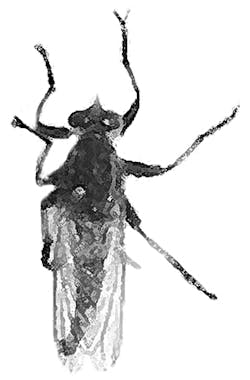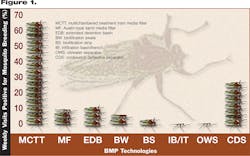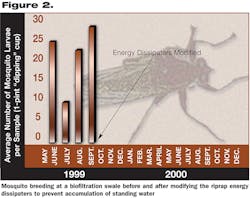Stormwater, BMPs, and Vectors: The Impact of New BMP Construction on Local Public Health Agencies
Public health agencies in the United States provide a broad range of services, with one unifying feature: protecting the health of the American people. Human health hazards come in many forms, but diseases transmitted by mosquitoes are among the most significant causes of human death and suffering around the world. Millions of people are affected by mosquito-borne illnesses each year, and it is because of this that the control of mosquitoes in the US is not taken lightly. As a result, almost anywhere you choose to live within the US, chances are there is a local public health agency near you that is responsible for the control of mosquitoes and other vectors. In some cases, a division of the city or county health department may administer a vector-control program; or perhaps an independent special district, such as Greater Los Angeles County Vector Control District (GLACVCD), is watching over your health by protecting you from vector-borne diseases. Ultimately, the goal of these programs and special agencies is to suppress vector populations using currently acceptable surveillance, management, and control techniques to break the cycle of disease transmission.
Vector-control services provided by local public health agencies are essentially an extension of your health coverage. These agencies employ a proactive approach to disease management rather than merely responding to a disease outbreak. Unfortunately, providing successful vector-control services often leads local residents to believe that there are no vector problems in their neighborhood. As a result, many vector-control agencies become victims of their own success. An excellent example of this is New York City. Two decades ago the city had a vector-control program in place, but because mosquito numbers were kept low and mosquito-borne diseases did not occur, local officials decided that the program was expendable and therefore discontinued funding. Twenty years later, a disease agent known as West Nile virus, never before present in the US, found its way into New York City. There, the disease spread rapidly by means of a thriving population of mosquitoes fully capable of transmitting it among humans, birds, and horses. This erroneous decision resulted in a widespread epidemic (67 human cases, including seven fatalities).
Mosquito- and Vector-Control Programs in the US
Public health agencies in the US are organized at several levels of government and specialization. At the federal level, the US Public Health Service’s Centers for Disease Control and Prevention (CDC) is the agency that oversees and provides consultation, surveillance, and epidemiological investigations (in conjunction with local agencies) on vector-borne diseases nationwide, as well as on exotic vectors and vector-borne diseases that might be imported into the US. Each state generally has its own agency that conducts similar functions as the CDC at the statewide level. Finally, at the local level, mosquito- and vector-control programs and special districts conduct the routine vector-borne disease and nuisance vector surveillance, management, and control functions.
Local public health agencies across the country function in accordance with local and state legislation, but they generally share many similarities. For example, in California most mosquito- and vector-control programs are organized into local governmental agencies known as independent special districts, meaning they are separate, autonomous agencies, accountable only to their local constituents; they have been created by election or by public petition out of need for a special service. Most are also nonenterprise districts, which means they provide specialized services that benefit one or more communities (not just individual citizens) without imposing user fees. To raise revenue, they are permitted by law to implement one or more communitywide property tax mechanisms, including ad valorem and/or benefit assessment. A board of trustees, who serve without compensation, performs governance and policy making of a mosquito- and vector-control district. By law, a trustee must be an elector from an area (city or county) within the district and is appointed by city council or county board of supervisors for a two- to four-year term; a district is required to have a minimum five-member board of trustees. Districts comprising four or fewer cities have one or more trustees appointed by the county board of supervisors. All mosquito- and vector-control districts in California derive their formation, enabling, organization, and authoritative powers from state law: the state’s Health and Safety Code.
Effect of New Regulations on Local Public Health Agencies
With the requirement of structural best management practices (BMPs) designed to mitigate pollutants in urban runoff, local public health agencies are bracing themselves for an increased workload. Urban and industrial areas throughout the US are already plagued by numerous manmade and natural mosquito-producing habitats. Breeding habitats in residential areas, flood-control channels, catch basins, and underground storm drain systems are regularly monitored and controlled for mosquitoes. Increased international travel, as well as growing national and international commerce, provided avenues for importation of exotic vectors and the diseases they transmit; this ensures the need for vector-control programs and special districts to continually monitor for public health vectors. To cope with the expected increase in habitats conducive to vector production as a result of BMP implementation, public health agencies will have to establish working relationships with stormwater engineers and seek increased funding. Strategies to achieve these goals are being considered and implemented by many public health agencies as you read this.
Vector-Control Costs at a Glance
The experience with Caltrans BMP structures has given GLACVCD the background and experience needed to estimate vector-control costs associated with BMP structures that require regular monitoring and control as a result of their design.
For reference, the annual taxation for vector-control services in GLACVCD’s service area is currently $3.65 per parcel. As municipalities race to comply with new standard urban stormwater mitigation plan (SUSMP) regulations, thousands of new BMP sites may be built within the GLACVCD boundary. Once these structures are in place, the district will have the obligation and responsibility to monitor and control all of these structures for mosquitoes and other vectors. During the two-year Caltrans pilot study, GLACVCD was required to intensively monitor all BMP sites to gather as much information as possible on vector breeding potential. During this intensive monitoring period (in which site visits were conducted at a rate greater than that typical for GLACVCD), approximately 770 hours were spent monitoring 16 BMP sites, and an additional 130 hours were spent on mosquito suppression—numbers that reflect the BMP/vector research effort.
Weekly monitoring of each BMP site for a year took an average of 28 hours. This figure includes only the time required to conduct fieldwork, such as monitoring and treatment; not included is the time necessary for larval identification, data analysis, and reporting.
Under current GLACVCD vector-control practices, all known potential mosquito-breeding sources are inspected at 10- to 14-day intervals. The worst-case scenario is one in which all BMPs are continuously holding water and need constant attention (requiring 14 hours of staff time per year for inspection and control services).
Based on a conservative estimate of 1,000 new BMP structures constructed within district boundaries, the district would have to hire seven additional vector-control specialists and require a budget increase of approximately $750,000 (calculated at GLACVCD’s standard hourly overall rate of $52.32; rates might vary for different organizations around the country). However, the bimonthly inspection rhythm can be continued only as long as mosquito-control agents with extended residual larvicidal effect are still available. With increasingly stringent water-quality requirements, as well as growing ecological and human health concerns, the list of control agents able to be legally applied to breeding sources that might be discharged to rivers or oceans has steadily decreased. If extended residual larvicides are lost, the above-estimated vector-control costs would have to be doubled.
In the boundary of the GLACVCD, the cost of vector-control services would have to be absorbed by the responsible agencies or property owners building and maintaining these structures. The California Health and Safety Code prohibits the creation of mosquito breeding sites and allows for violators to be fined up to $500 per day. Since the actual number of structures will most certainly exceed the 1,000 used in our example, it is worthwhile to contemplate how important it will be to design mosquito breeding habitat out of these BMP structures, thereby keeping the necessary monitoring and actual mosquito breeding to a minimum.
GLACVCD recently had an opportunity to experience the potential impact that BMP structures could have on day-to-day operations. In 1999, GLACVCD became involved in a study spearheaded by the California Department of Transportation (Caltrans). This study had many objectives, one of which focused on vectors associated with selected BMPs. The latter part of the study was conducted in collaboration with the California Department of Health Services’s Vector-Borne Disease Section (VBDS), three other southern California vector-control agencies, and stormwater management consultants. (See the related article in this issue with details of the study results.) The role of GLACVCD was to conduct weekly vector monitoring and control services for 16 operational stormwater BMP structures, representing eight different technologies, built within district boundaries. Data collected during a two-year period (May 1999–April 2001) were used to make a preliminary assessment of vector production potential, design and maintenance recommendations to minimize vector breeding, and estimates of vector-control costs.
Many of the BMP technologies employed in the Caltrans study were found to breed mosquitoes at some point during this study (Figure 1). BMPs that held permanent standing water as a result of their design (i.e., multichambered treatment train [MCTT] media filter devices) produced mosquitoes most frequently. Other designs, such as Austin-type sand media filters, only occasionally held standing water suitable for mosquito breeding, often as a result of clogging or mechanical failures (i.e., malfunctioning sump pumps). During the study, GLACVCD and other agencies recommended design modifications and “mosquito proofing” that made a significant impact on the number of mosquitoes breeding in modified structures. For example, biofiltration swales, which initially provided mosquito habitat within riprap energy dissipaters, were modified to prevent water ponding. Figure 2 illustrates the dramatic results these changes had on the suitability of these structures to produce mosquitoes.
The results of the study clearly indicate that proper design and construction, in conjunction with routine quality maintenance, have a significant impact on vector habitat and subsequent vector breeding within BMP structures. One of the most important design considerations is minimizing water accumulation and retention (water-retention periods not exceeding 72 hours) to achieve mosquito control. However, the study also showed that other problems, such as improper sloping in settling basins and sump-outlet drains placed higher than the invert of the inlet pipe, might allow mosquitoes to breed. Significant consideration should also be given to the possibility of nonstormwater runoff (i.e., irrigation, vehicle washing, and spills) collecting within BMP structures, particularly in urban areas. For example, BMPs built within housing developments might hold standing water suitable for mosquito breeding far longer than intended by design (more than 72 hours) because of frequent replenishment from irrigation runoff.
Conclusions
Those involved in BMP implementation, operation, and maintenance have many responsibilities that need to be addressed, reaching far beyond simply trying to comply with new urban runoff regulations. Some structural BMPs create potential dangers inherent in their design or location. Deep wells, vaults, basins, and ponds can be dangerous to those who are unaware of their presence (both children and adults), as well as to those involved in cleaning and maintaining these structures. BMPs that collect trash or hold standing water might provide habitat for rats and mice and might also produce vectors. Eventually, stormwater engineers, public works and transportation agencies, and other BMP owners will have to face these issues. To prevent vector production, they will have to interact with local public health agencies to achieve a solution.
By involving local public health agencies in the BMP design, construction, and maintenance process, including monitoring for vectors and vector habitat, public works and transportation agencies can ensure that these installations will not contribute to creating additional habitat suitable for breeding vectors. Maintaining these partnerships will also allow new BMP designs and new deployments to be comprehensively assessed for both their water-quality improvement and their potential public health hazard. Such monitoring efforts should take into account even BMP designs that have shown little propensity for vector breeding, since designs that might be a minor problem in one region could prove to be a major problem at a different location because of varying environmental conditions. For example, local irrigation runoff can significantly alter the expected function of a BMP by providing an unexpected and often continuous influx of water.
It seems clear that vector-control agency involvement should be considered for a
variety of reasons. At a minimum, public works agencies should consider monitoring newly constructed BMPs for vector production. The following guidelines are recommended:
- Monitoring should take place for at least the first year of deployment on all new BMP structures, particularly those that are new or untested designs.
- Monitoring should be undertaken for the entire pilot deployment of any proprietary devices that might hold permanent pools of water.
- Monitoring should be undertaken when existing BMPs are retrofitted or substantially modified in some manner.
How Can Public Works and Transportation Agencies Benefit From Local Public Health Agency Involvement?
The holistic approach to urban stormwater-quality management now being embraced often fails to take into account the effects of various stormwater improvement devices upon overall public health. However, considering the multitude of BMP structures that will have to be put in place under the new standard urban stormwater mitigation plan regulations, this can no longer be the case. Therefore, it is advisable that consultation regarding potential public health concerns should be sought during the design process.
How can local public works and transportation agencies best interact with local public health agencies?
- Investigate which local public health agency (city-/county-administered program or independent vectorcontrol district) is responsible for vector control in your jurisdiction.
- Contact those agencies and define the guidelines under which public health officials should be consulted regarding your project.
- Form an interagency advisory committee that considers design and site selection before implementation of new structures.
How can local public health agencies help?
- Their extensive knowledge of biology and ecology of various disease vectors will be useful during design plan review. They might be able to detect factors conducive to vector production or harborage that have been overlooked.
- They can provide site/location advice (certain BMP designs might be unsuitable for specific locations—i.e., ecological factors, near schools).
- They can provide monitoring services for a period of time after completion of construction that will help pinpoint features conducive to vector breeding. Improvements can be made based on these observations.
We all want to live in an ecologically sound and healthy environment. Improving our water quality will significantly contribute to enhancing our marine and freshwater environments. However, though water cleanup enhances public health to a certain extent, diminishing the public’s safety from vector-borne disease should not be countenanced. Intensive cooperation between stormwater engineers and public health agencies should lead to an acceptable compromise between clean water and a healthy populace.




